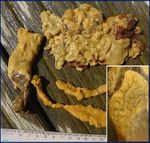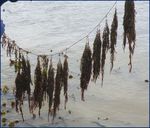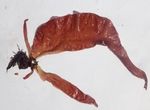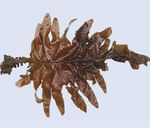South Devon AONB Estuaries Partnership Avon Estuary Marine Biosecurity Plan 2017- 2020
←
→
Page content transcription
If your browser does not render page correctly, please read the page content below
South Devon AONB Estuaries Partnership
Avon Estuary Marine Biosecurity Plan 2017- 2020
This local estuary biosecurity plan has been produced by the South Devon AONB Estuaries Partnership, the
local relevant authorities, organisations, owners, users and community of the Avon Estuary with support
from Robin Payne and Sarah Brown from C2W.
Non-Native Species (NNS) are those that have been transported outside their natural range by human
activity. This may be the deliberate movement of a species, for aquaculture for example, but more
frequently the accidental transport of species as ‘hitchhikers’ such as those attached to the hulls of vessels.
When a NNS grows rapidly and starts to upset our environment, economy, health and the way we live they
are often referred to as Invasive Non Native Species. Whether an NNS becomes invasive or not is
unpredictable and all pose some threat - in this document all are referred to as NNS.
Biosecurity means taking steps to ensure that good practices are in place to minimise the risk of spreading
non-native species. A good biosecurity routine is essential, even where invasive non-natives are not
thought to be present. No single business or sector has been targeted in this plan, as everyone has a vested
interest and role to play in successful biosecurity. All actions within the plan are undertaken on a voluntary
basis
The site
© Crown Copyright and/or
database rights. Reproduced by
The Avon Estuary lies on the south coast of Devon, it permission of the Controller of Her
Majesty’s Stationery Office
and the UK Hydrographic Office
is a ria-type estuary with three small tributaries that (www.GOV.uk/UKHO)
winds through a narrow steep-sided valley from
Aveton Gifford to the sea in Bigbury Bay. The inlet has
been substantially filled with alluvial sediments and
almost dries at low tide except for the very shallow
river channel. Sediments dominate the inlet with
some areas of bedrock at the entrance and some
upper shore hard substrata in the upper reaches.
Saltmarsh is present between Aveton Gifford and
Hexdown, including a recently tidally flooded area at
South Efford – the saltmarsh is heavily ‘contaminated’ with the INNS cordgrass.
The entire inlet lies within the South Devon Heritage Coast and AONB. The estuary is presently being
considered as a Marine Conservation Zone. Small colonies of seabirds are known to breed within the inlet
and it is a nationally important site for overwintering common sandpiper and greenshank - also frequented
by otters. The inlet is a major nursery area for bass; Atlantic salmon and sea trout migrate to the inlet to
spawn up river.
The area of the estuary itself is predominantly owned by the Duchy of Cornwall, with areas of the seabed
rented to the Bantham estate and other landowners for the provision and management of boat moorings –
mostly drying swinging block & chain moorings, boat owner DIY maintained. Local boat facilities are limited
to the moorings and a very limited slipway provision at Aveton Gifford only; most owners service their
boats at local boatyards elsewhere or DIY. Estuary is growing in popularity with trailered stacks of SUPs,
kayaks & canoes; kitesurfing popular at the mouth of the estuary. Local mariculture of Pacific oysters.Avon Estuary - Top Ten Most Unwanted
Two Already Here - Marine Non-Native Species To Live With
Common cord grass (Spartina anglica) is a hybrid of a native species and an American species.
First recorded around 1890 and widely planted a binder of tidal mud-flats and saltmarshes in
many estuaries in England and Wales and has also spread through natural colonisation.
Common cord-grass can form dense stands leading to a loss of habitat for wintering waders
and wildfowl.
Wireweed (Sargassum muticum) is a distinctive olive-brown seaweed originating from Japan. It
is often over 1m long and its lateral branches hang like washing from a line when held out of
the water. It is distributed widely around the UK. Wireweed competes with native seaweeds
and sea grasses through rapid-growth, shading and abrasion. It can be a hazard to boating due
to entanglement of propellers.
Eight Most Likely To Arrive In The Future - Marine Non-Native Species To Look Out For
Carpet sea squirt (Didemnum vexillum) was first recorded in 2008 in Holyhead and has at several locations
in the UK. It forms pale orange, cream or off-white colonies of extensive thin sheets and can form long
pendulous outgrowths. Colonies can rapidly overgrow other fauna and occupy a substantial proportion of
available space. It can achieve very extensive coverage of the seabed, smothering species such as mussels
and oysters.
Orange-tipped sea squirt (Corella eumyota) is native to the Southern hemisphere was first discovered
in 2004 and has spread rapidly around the UK. It is a solitary sea squirt, 2-4 cm long, which often
attaches to hard substrates such as cobbles, boulders, ship hulls and shells of mussels and oysters. It
may threaten oyster and mussel farms through fouled gear and by smothering and outcompeting
cultures.
Chinese mitten crab (Eriocheir sinensis) was first introduced to the Thames Estuary in 1935,
and now established in several sites throughout England and Wales. Juveniles occur in lower
estuaries and marine habitats then, as they develop, migrate upstream, into freshwater and
brackish systems. A voracious predator that will consume a range of native species, impacting
on invertebrate and fish populations. Adult crabs burrows into river banks causing bank
collapse, increasing erosion and river turbidity.
Asian shore crabs (Hemigrapsus sanguineus and H. takanoi) are native to the NW Pacific. Both species
were first identified in the UK in 2014 They are small squarish shaped crabs with three teeth on either
side of well-spaced eyes. They occur on muddy and rocky shores and in sheltered estuaries and port
areas, they have also been found in oyster reefs.They can out-compete the native shore crab and could
have a negative impact on prey species such as juvenile mussels and oysters.
Pacific oyster (Magallana gigas) is native to Japan and SE Asia. Introduced to the UK in the 1960s for
commercial purposes, feral populations have established in SE and SW England and Wales. Pacific oyster is
an ecosystem engineering species, altering habitats and ecosystems through reef formation having a
negative impact on native biodiversity. They can foul artificial structures and make shores hazardous
because of the sharpness of the shells.
Slipper limpet (Crepidula fornicata) is native to North America and arrived in England in the late 19th
Century and is now well established on the southern coasts of England and Wales. It can smother
seabed species, alter seabed habitat structure dramatically and compete for food and space with other
filter-feeding species including mussels and oysters.
Wakame (Undaria pinnatifida) is a fast-growing brown kelp native to the NW Pacific with fronds reaching
1-3m. The blade has a distinct midrib. Tolerant of a wide range of temperatures and salinities and grows
well in estuarine conditions. It is particularly prevalent along the S coast of England. It competes for space
with native kelp species and may be a nuisance fouling jetties, vessels, moorings and buoys.
Devil’s tongue weed (Grateloupia turuturu) is a large red alga from the NW Pacific with broad
slippery blades and a very small holdfast. Present in the UK since 1969 and now spreading more
aggressively. It grows on artificial and natural hard substrata, including rock pools, shells and stones
where its large size and high reproductive output mean it can out-compete many native types of
seaweed.PATHWAY, RISK AND BIOSECUIRTY ACTIONS - this section sets out the likely pathways for non-native species introduction to the Avon estuary, the range of vessels and other
vectors which could carry them – both into or out of the estuary. A brief analysis of the pathway and likelihood gives a high, medium or low risk rating. Biosecurity actions propose
appropriate and achievable actions to minimise this risk given current knowledge, local management capacity and resources.
Pathway/Vector Detail/Activity Analysis and Risk Biosecurity Actions Comments
Assessment
Fishing vessels Fouled nets and gear LOW Discourage local discard of waste Where do they fish
Disposal of by-catch Discourage open hull maintenance within
Ballast water estuary
Frozen sea water
Hull fouling
Recreational vessels e.g. yachts, cruisers MEDIUM Encourage biosecurity awareness and active Yachts mainly S coast, Channel Is., France, but
(power and sail) Hull fouling vigilance by users via moorings hire and some worldwide includes Transfer between water
including yachts, day Shellfish food waste local signage, RYA, etc. bodies on equipment and clothing e.g. kayaks,
sailor/trailer In-water hull cleaning dive gear, jet-skis, fishing gear
launched boats and
kayakers
Aquaculture -shellfish Oyster bags Import/export MEDIUM Follow industry led biosecurity plan
of live stock
Marine Engineering In-water cleaning MEDIUM Promote hull maintenance best practice – No local boatyard or boat maintenance
including boat Slipway cleaning capturing and removing all debris to landfill infrastructure
maintenance where this occurs
Port infrastructure – Construction and LOW Highlight risk within AONB Planning Use of slow moving vessels in construction or
Walls/breakwaters/je maintenance, importation Guidance re. construction barges etc. dredging, often from outside the local water body
tties/ of materials Promote use of natural materials within Dredged material disposal
piers/slipways hard developments encouraging a high
health natural marine community.
Relocation of Movements or disposal of LOW Prepare and promote a mooring tackle Avon has high proportion of mooring tackle DIY
equipment buoys, anchor chains & biosecurity guide incl. maintained
blocks
Live release Deliberate release of LOW Raise awareness of biosecurity risks of Reports of unused stock of the American lobster,
unwanted live food / bait releasing live NNS into local waters – (may Homarus americanus have been thrown overboard
/ aquarium discards also impact local genetic provenance) – from cruise ships. Examples of Buddhist release of
relevant media e.g. Notices same species Fly tipping’ of post-processed shell
Marine debris and Tidal and ocean currents LOW – part of natural Add to general litter risk message Many small species such as bryozoans, barnacles
litter dispersal / migration Highlight biosecurity risk within beach clean and tube worms can survive on small plastics.
process event – warn against refloating of fouled Plastic litter can travel long distances e.g. from N
flotsam AmericaHELP TO STOP THE SPREAD OF MARINE NON-NATIVE SPECIES
Simple Biosecurity Actions and Measures for all who use the Avon estuary
‘CHECK – CLEAN – DRY’: Non-native species cannot survive long term desiccation.
• Check all vessels (dinghies, trailer-sailors, jet skis, kayaks) and equipment
(trailers, dive gear etc.) which can be removed from the water
• Clean them thoroughly
• Dry completely before using again
See www.nonnativespecies.org/checkcleandry and @CheckCleanDryGB for further details
When recovering a trailer, dinghy, PWC or RIB, drain water from every part of the boat and all equipment
that can hold water
For boats kept in the water permanently, hull fouling is the main means of transfer. Clean yacht hulls well
away from the water and collect all scrapings and dispose of to landfill.
If you use a scrubbing grid, only scrub off the fouling and not the underlying paint. Collect all scrapings and
dispose of to landfill.
Select a wash-down facility that collects residues and wash down water.
Make sure that the hull of your yacht has an effective anti-foul and renew on a regular basis. Keep
propellers, bow thrusters and anodes clear of fouling.
Look out for vessels with high level of hull biofouling, advise the boat owner of the biosecurity risk and
inform the relevant moorings manager.
Follow best practice and encourage others to do the same. Go to the Green Blue
www.thegreenblue.org.uk and to www.nonnativespecies.org for advice
Keep vigilant, you don’t need to be an expert to spot something new or unusual. Report any suspicions on
invasive species sightings to the relevant moorings manager. Send records of sighting to iRecord -
www.brc.ac.uk/irecord/enter-non-native-records or Sealife Survey - www.mba.ac.uk/recording
Download species identification cards from the Marine Biological Association:
www.mba.ac.uk/shore_thing/documents/Marine_cards_2015.pdf [20.7MB PDF]
www.mba.ac.uk/sites/default/files/AlienInvadersCards2013.pdf [4.4MB PDF]
www.mba.ac.uk/sites/default/files/downloads/ID%20NNS%20English.pdf [15MB PDF]
Citizen Science NNS survey recording schemes - www.mba.ac.uk/citizen-science#b38Keeping a watchful eye – Site monitoring and surveillance
Everyone can play a part in looking out for marine non-native species; you don’t need to be a marine biologist. Don’t
aim to identify every species, concentrate on the “ten most unwanted” on Page 2. Become familiar with the NNS
already present. Report any major changes in their abundance. Look out for anything new especially unusual growth
patterns, areas which have obviously quickly been taken over or which just don’t look ‘normal’ . Take photos, a grid
reference, estimate the quantity/area covered and report to the relevant moorings manager. You can also record
your sighting using the iRecord website www.brc.ac.uk/irecord or Sealife Survey - www.mba.ac.uk/recording . Think
about combining monitoring for NNS as part of other routine checks and inspections which you may already be
involved in.
What to do if there’s an incident or breach of biosecurity
Some biosecurity threats may need a co-ordinated response from the relevant authorities. Anyone can help by
raising the alarm in these cases and providing the authorities with information about the threat. The most likely
incidents are the arrival or a vessel with heavy biofouling from a distant location. Here is some guidance on what to
do if you spot a suspect vessel or species.
Biosecurity Threat What to do
Unplanned or unexpected arrival of Collect any information on you can on the vessel (name, type, location in
a vessel within the estuary which harbour, port of origin/recent port visits)
poses a high risk of introducing NNS Make a simple assessment of the level of biofouling
or discovery significant marine Alert relevant authorities & the relevant moorings manager
debris with extensive bio-fouling
Discovery of a new NNS on the Photograph specimen. Record location and approximate size of area
unwanted list or suspicious marine affected. If feasible keep specimen in a pot/bucket of seawater for expert
growth to examine. Report to relevant moorings manager
Key Contacts
Contact Responsible for
AONB Coordination of Avon Estuaries Management Plan and Avon Estuary Forum -
Nigel.Mortimer@SouthDevonAONB.org.uk – 01803 861465
CEFAS Management of aquaculture – Fish Health Inspectorate fhi@cefas.co.uk –
01305 206700
D&S IFCA Management of a sustainable marine environment & inshore fisheries -
www.devonandsevernifca.gov.uk
Duchy of Cornwall Estuary Fundus owner – www.duchyofcornwall.org
EA Protect & enhance the environment - Water Quality - nick.whatley@environment-
agency.gov.uk
GB NNSS * Non-Native Species Secretariat - alertnonnative@ceh.ac.uk
www.nonnativespecies.org
MMO Marine planning, licensing, fisheries management, monitoring & enforcement,
protecting the marine environment -
claire.bowers@marinemanagement.gsi.gov.uk – 02080 266018
Mooring managers - various Non mooring holders, contact AONB
NE Statutory Marine Conservation Advisor - Jan.Maclennan@NaturalEngland.org.uk –
02080 267450
* Contact for escalation of significant NNS invasions ( - biodiversity, - aquaculture)
Further Advice
Distribution information on species from the National Biodiversity Network www.nbnatlas.org
The Green Blue for biosecurity advice http://thegreenblue.org.uk/Boat-Users/Antifoul-and-Invasive-Species
Great Britain Non Native Species Secretariat www.nonnativespecies.org including their marine and biosecurity pages
Biosecurity in the field , NNS Information Portal and Identification sheetsYou can also read


























































